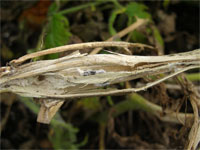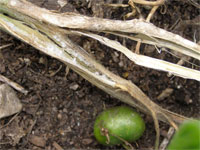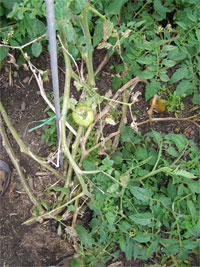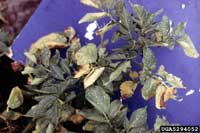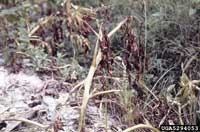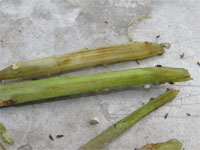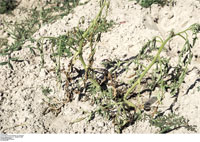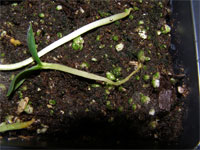Extension > Garden > Diagnose a problem > What's wrong with my plant? > Vegetable > Tomato > Plant wilts
Tomato > Whole plant > Plant wilts
1 of 4
White Mold
Sclerotinia sclerotiorum
- Dark, firm water-soaked lesion on stem
- Girdled stems die and turn bone white
- Inside dead stems are black mouse poop shaped sclerotia
- Fruit are soft and rotted
- Cottony white mycelia inside and outside infected stems when humidity is high
- Favored by cool humid conditions
- More information on White Mold
2 of 4
Verticillium Wilt
Verticillium albo-atrum, Verticillium dahlia
- A yellow wedge shaped lesion on leaf often with a brown center
- Leaves yellow and wilt, often one side only
- Lower leaves wilt first, eventually whole plant wilts
- In a lengthwise cut of the stem near the soil line, veins are tan, center is green
- Common in cool temperatures 68° to 75° F
- More information on Verticillium Wilt
3 of 4
Fusarium Wilt
Fusarium oxysporum
- Problem in heirloom varieties; most modern cultivars are resistant
- Leaves yellow and wilt, often one side only
- Lower leaves wilt first, eventually whole plant wilts
- In a lengthwise cut of the stem near the soil line, veins are brown, center is green
- Occurs when air and soil temperature are above 80° F
- More information on Fusarium Wilt
4 of 4
Damping Off
Pythium sp. Rhizoctonia sp. Phytophthora sp. and others
- Occurs in seedlings and young transplants only
- First stem turns dark at soil line
- Plant wilts, turns dark and rots
- More information on Damping Off



